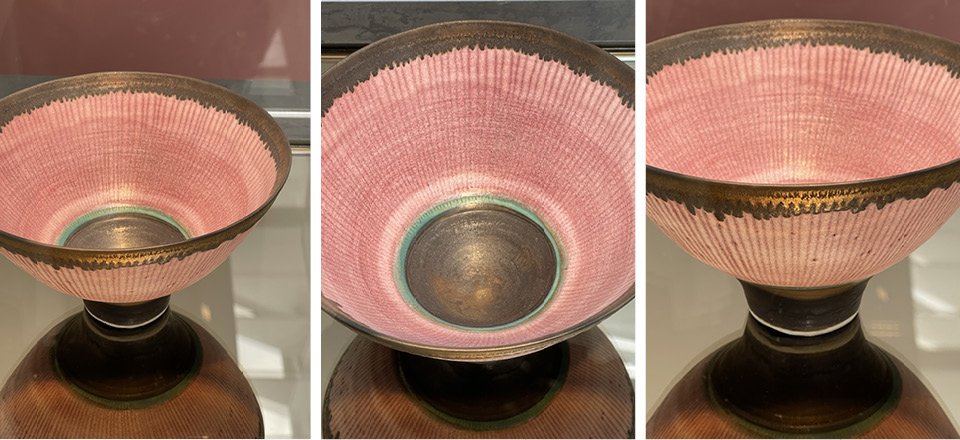The Adventure of Pottery
We headed down to Cambridge for the day to explore the stunning Lucie Rie exhibition, The Adventure of Pottery.
One of the most celebrated potters of the 20th century and with a career spanning more than six decades, Lucie Rie is a true inspiration.
We were really inspired by her methods of glazing, such as her use of golden manganese oxide which gives Rie’s bowls and vases the quality of precious metals. She often combined these with bands of contrasting glaze to highlight the rims of her vessels and sgraffito decoration, giving each piece a jewel-like richness.
Along with sgraffito, she decorated pots with inlaid lines, this involved scratching a line in the unfired clay before filling the groove with coloured pigment. She would often use sgraffito and inlay in the same piece, creating a positive and negative version of the same design.
Ries early life....
Born in Vienna in 1902, at a time when most ceramicists were male, Lucie was inspired by her uncle’s Roman pottery collection, and in 1925 decided to set up her own pottery studio. But it was in 1938, when Rie fled to London that her potters career began as she made ceramic buttons for haute couture fashion houses during and after the war. Each button had to be made to match the exact colour of the garment, which is where Rie’s experimentation and accuracy of glazes flourished.
Rie used an extensive palette of colours and realised buttons in both abstract shapes and figurative forms that included flowers, shells, leaves, stars, fossils, and knots. Her choice of clays was equally eclectic, and she continually reformulated recipes for lustres and glazes to create new surface effects.
“The piece that I’m instantly drawn back to is the final piece Lucie created at the grand age of 88. Sitting at the back of the exhibition room, enclosed in a glass box with a subtle mirrored base, was a vibrant bowl full of intricate detail and a beautiful combination of glazes that wrapped around the entire shape. The bright rhubarb pink glaze and stripe of turquoise is quite different to Lucie’s usual style and was one of the pieces that had a flurry of colour. It felt like Lucie wanted to celebrate all the many glazes and techniques she had learnt over the years and encapsulate this into one piece, but in the most beautiful and unique way.” Hannah
“For me it was the Conical Bowl 1970-1975 made from porcelain. I loved the combination of inlay and sgraffito. The contrast of her practical and dusty studio, imagining this jewel- like piece emerging from the kiln.” Abby
The Guardian wrote a lovely piece on Lucie and the exhibition which sums up the beauty and enormity of Rie’s work, even nearly 20 years after her death.
‘‘Rie’s pottery is art now: extremely precious, lusted after by collectors and displayed in museums in glass cases (those at Kettle’s Yard are designed by David Kohn Architects). But no matter how exquisite, nor how rarefied the places in which one encounters it, there’s still no getting away from the fact that form and function are inseparable; that you can imagine (dream) not only of owning it, but of using it, trying hard not to worry about chips.
And this makes it so much more than a mere feast for the eyes. Rie’s practice, careful and ever modest, has strange effects on a person. To look at it is to want to live in a different, better way. This has to do with ritual; with the incorporation of beauty into the everyday. The final piece in this exhibition is one of the last bowls she ever made (in 1990, when she was 88). It has a glaze the colour of forced rhubarb, a manganese drip (loose, vertical lines) and narrow turquoise bands, and such is its harmony, it seems almost to vibrate. How, you wonder, can a thing be so straightforward and yet so absolutely extraordinary?’’ Rachel Cooke for The Guardian.
If you want to visit the exhibition Rie’s pieces will be on display at The Holburne Museum in Bath and will be open from 14th July 2023 – 7th January 2024.










